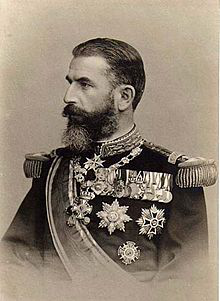

King of Romania
20 April 1839 Sigmaringen, Hohenzollern-Sigmaringen, German Confederation
10 October 1914(1914-10-10) (75) Sinaia, Kingdom of Romania
NamesKarl Eitel Friedrich Zephyrinus Ludwig
King of Romania from 1866 to 1914 "Carol I" redirects here. For the 2009 film, see Carol I (film). King of Romania Carol IKing of RomaniaReign15 March 1881 – 10 October 1914Coronation10 May 1881SuccessorFerdinand IDomnitor of RomaniaReign20 April 1866 – 14 March 1881PredecessorAlexandru Ioan CuzaSuccessorHimself as King of RomaniaBorn(1839-04-20 ) 20 April 1839 Sigmaringen, Hohenzollern-Sigmaringen, German ConfederationDied10 October 1914(1914-10-10) (aged 75) Sinaia, Kingdom of RomaniaBurialCurtea de Argeș, RomaniaSpousePrincess Elisabeth of WiedIssuePrincess MariaNamesKarl Eitel Friedrich Zephyrinus LudwigHouseHohenzollern-SigmaringenFatherKarl Anton, Prince of HohenzollernMotherPrincess Josephine of BadenReligionRoman CatholicismSignature Carol I or Charles I of Romania (20 April 1839 – 10 October 1914), born Prince Karl of Hohenzollern-Sigmaringen, was the monarch of Romania from 1866 to his death in 1914, ruling as Prince (Domnitor) from 1866 to 1881, and as King from 1881 to 1914. He was elected Prince of the Romanian United Principalities on 20 April 1866 after the overthrow of Alexandru Ioan Cuza by a palace coup d'état. In May 1877, Romania was proclaimed an independent and sovereign nation. The defeat of the Ottoman Empire (1878) in the Russo-Turkish War secured Romanian independence, and he was proclaimed King on 26 March 1881. He was the first ruler of the Hohenzollern-Sigmaringen dynasty, which ruled the country until the proclamation of a socialist republic in 1947. During his reign, Carol I personally led Romanian troops during the Russo-Turkish War and assumed command of the Russo/Romanian army during the siege of Plevna. The country achieved internationally recognized independence via the Treaty of Berlin, 1878 and acquired Southern Dobruja from Bulgaria in 1913. In 1883 the king made a top-secret military alliance with the Austro-Hungarian Empire, despite popular demands against Hungary. When World War I broke out he was unable to activate the alliance. Romania remained neutral and in 1916 joined the Allies. Domestic political life was organized around the rival Liberal and Conservative parties. During Carol's reign, Romania's industry and infrastructure were much improved, however this process also resulted in major scandals, including the Strousberg Affair which personally implicated Carol. Overall, the country still had an agrarian-focused economy and the situation of the peasantry failed to improve, leading to a major revolt bloodily suppressed by the authorities. He married Princess Elisabeth of Wied on 15 November 1869. They only had one daughter, Maria, who died at the age of three. Carol never produced a male heir, leaving his elder brother Leopold next in line to the throne. In October 1880 Leopold renounced his right of succession in favour of his son William, who in turn surrendered his claim six years later in favour of his younger brother, the future king Ferdinand.

We use cookies
We use cookies and other tracking technologies to improve your browsing experience on our website, to show you personalized content and targeted ads, to analyze our website traffic, and to understand where our visitors are coming from. Privacy Policy.